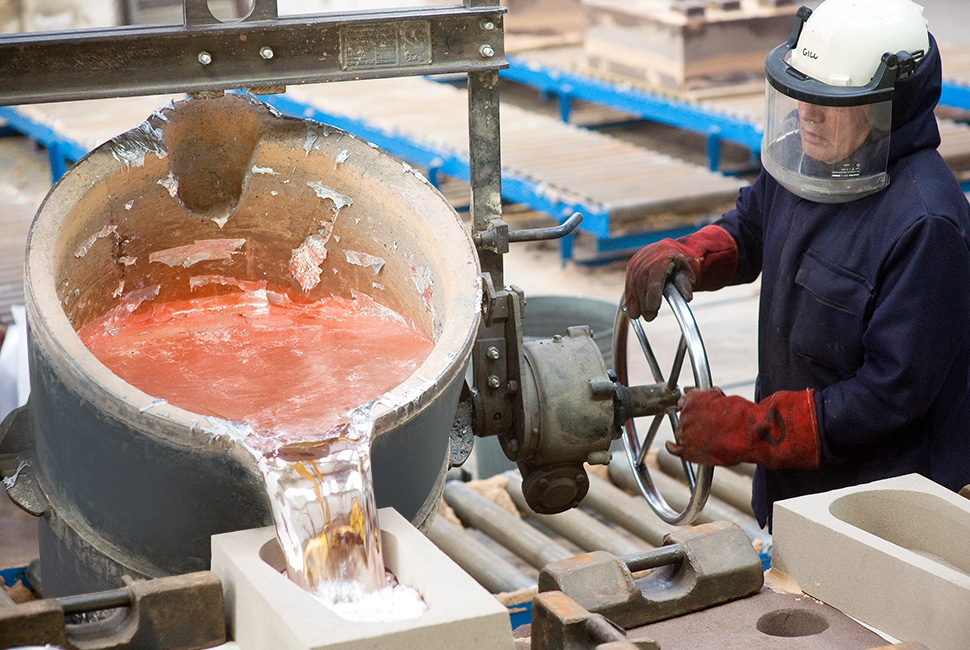A Biased View of Aluminum Castings Company
Table of ContentsAluminum Castings Company - An OverviewWhat Does Aluminum Castings Company Do?What Does Aluminum Castings Company Mean?Aluminum Castings Company - An OverviewAluminum Castings Company Fundamentals ExplainedNot known Factual Statements About Aluminum Castings Company A Biased View of Aluminum Castings CompanyWhat Does Aluminum Castings Company Mean?
There are two main kinds of die casting utilized in the light weight aluminum spreading sector: hot chamber die casting and chilly chamber die spreading. The key difference between these techniques is exactly how the molten metal is supplied to the mold and mildew. In warm chamber die casting, frequently utilized for lower melting factor metals, the melting pot is directly connected to the maker, and a plunger compels the product with a gooseneck right into the die tooth cavity.
All About Aluminum Castings Company
In these techniques, the mold is intentionally destroyed or broken away in order to remove the ended up aluminum spreading. Common procedures under the classification of expendable mold spreading include (investment casting),,, and investment casting. When manufacturing customized light weight aluminum parts utilizing expendable molds, producers put liquified light weight aluminum or aluminum alloys into the mold, which is after that broken apart to release the strengthened metal component.
The is one of the earliest and most favored kinds of aluminum casting. It involves condensing specialty factory sand, commonly enhanced with clay or resin, around an exactly crafted multiple-use pattern that identifies the form and inner details of the ended up aluminum item. The pattern system incorporates risers and vents to handle the flow of liquified metal and to stop casting flaws such as shrinking porosity.
Aluminum Castings Company - Questions

This mold and mildew is after that preheated prior to the pouring of liquified aluminum or aluminum alloy. As the steel loads the covering, it catches the elaborate details and fine surface coating of the mold. As soon as cooled, the ceramic is mechanically or chemically escaped, permitting the removal and splitting up of specific cast components.
The Buzz on Aluminum Castings Company
Irreversible mold and mildew casting uses multiple-use steel mold and mildews and is perfect for mass production with regular news top quality and less waste. Expendable mold spreading utilizes single-use molds, like sand or foam, supplying style flexibility and reduced tooling expenses for models or short runs. Die casting is best for creating high volumes of light weight aluminum parts that call for tight resistances, great information, and smooth surfaces.
The Toshiba Maker DC-J Series consists of pass away casting machines suitable for light weight aluminum. Recognized for their robust construction and high injection performance, these devices guarantee reliable and exact casting (Sand Molding).

While aluminum can be utilized in its pure type, it is often alloyed with various other steels to improve its properties or the buildings of the various other metals. These alloys provide boosted efficiency for different applications. Aluminum alloys are classified right into eight series, phoned number from one to 8. The very first digit(s) of the number suggest the primary alloying component incorporated with light weight aluminum.
Unknown Facts About Aluminum Castings Company
This alloying boosts the strength and firmness of aluminum but lowers its ductility and rust resistance. The 3000 collection alloys are largely alloyed with manganese.
Additionally, it features high ductility and an extremely smooth completed surface. The 4000 series alloys are alloyed with silicon, which lowers the melting point and improves fluidness. This makes it a prominent choice for casting, as it is simple to develop in its molten state. The 4000 collection is also frequently used as a filler for welding and brazing applications.
See This Report about Aluminum Castings Company
This collection is classified as a high-strength alloy, particularly fit for sheet and plate applications as a result of its superb weldability. Its resistance to corrosion from acids and antacid makes it ideal for use in harsh and aggressive settings (Sand Mold). The 6000 collection alloys are alloyed with both magnesium and silicon, giving an equilibrium of stamina, mechanical properties, and deterioration resistance
Handling the 6000 collection needs specialized and advanced devices, which can be intricate and costly. This collection is understood for its excellent rust and oxidation resistance, as well as its simplicity of finishing, therapy, and workability. The 7000 collection aluminum alloys are the toughest and most resilient amongst light weight aluminum kinds, with strength comparable to about two-thirds of industrial-grade A3 steel.
An Unbiased View of Aluminum Castings Company
Zinc is the main alloying component in the 7000 series, enhancing the firmness of the light weight aluminum, although zinc's hardness resembles that of light weight aluminum on the Mohs scale. The 8000 collection light weight aluminum alloys are mainly alloyed with tin, together with tiny amounts of copper and nickel (Sand Molding). While these alloys provide reduced toughness compared to other series, they stand out in machinability and wear resistance
Light weight aluminum cast heatsinks are electrically conductive, permitting them to be grounded successfully. They are commonly cast with incorporated functions that lessen the requirement for additional procedures, such as added machining or assembly, bring about further expense financial savings. Aluminum spreading is often made use of to produce braces for both heavy-duty commercial tools and home appliances.
The smart Trick of Aluminum Castings Company That Nobody is Discussing
The single-piece construction of aluminum brackets enhances their toughness and toughness, reducing the probability of failing. If openings are needed, they can be consisted of straight in the casting mold and mildew, lessening the demand for post-production finishing (https://www.huntingnet.com/forum/members/alumnmcstngs.html). Suppliers have actually progressively taken on light weight aluminum spreading for golf devices as a result of its resilience, stability, and versatility in shaping